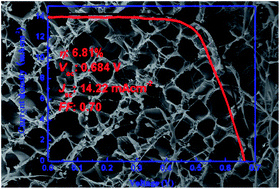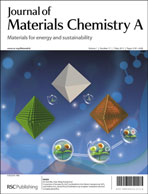A microporous hydrophobic polyaniline (PANi) integrated poly(hexamethylene diisocyanate tripolymer/polyethylene glycol) [poly(HDT/PEG)] gel electrolyte was successfully synthesized via a two-step aqueous solution polymerization process. An ionic conductivity of 12.11 mS cm−1 at room temperature was obtained for the PANi integrated poly(HDT/PEG) gel electrolyte, which was well characterized using scanning electron microscopy, Fourier transform infrared spectroscopy, electrochemical impedance spectroscopy, and cyclic voltammetry. Morphological observations showed that the resultant gel electrolyte exhibits microporous structure, providing space for holding I−/I3− liquid electrolyte. The integration of PANi with poly(HDT/PEG) causes a lower charge-transfer resistance and higher electrocatalytic activity for the I−/I3− redox reaction. A dye-sensitized solar cell with a photo-to-electric conversion efficiency of 6.81% was obtained by sandwiching PANi integrated poly(HDT/PEG) gel electrolyte between a TiO2 anode and a Pt counter electrode, under illumination with simulated solar light of 100 mW cm−2 (AM 1.5).

You have access to this article
 Please wait while we load your content...
Something went wrong. Try again?
Please wait while we load your content...
Something went wrong. Try again?


 Please wait while we load your content...
Please wait while we load your content...